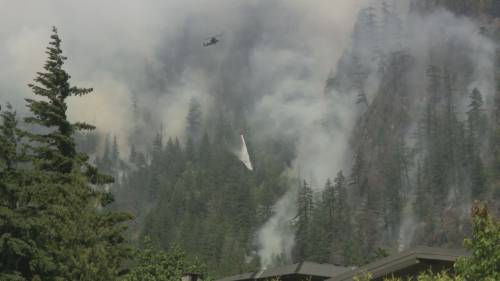The picturesque mountain community of Squamish, British Columbia finds itself in the crosshairs of nature’s fury as an aggressive wildfire continues to spread through the region’s dense forests, forcing hundreds of residents to prepare for potential evacuation. What began as a small blaze has rapidly evolved into a significant threat, challenging emergency response teams and putting local authorities on high alert.
“We’re witnessing unprecedented fire behavior for this time of year,” said Regional Fire Chief Morgan Wilkins during yesterday’s emergency briefing. “The combination of unseasonably dry conditions and shifting winds has created a perfect storm scenario that demands our immediate and full attention.”
According to the BC Wildfire Service, the fire has already consumed over 200 hectares of forested area and continues to grow despite concentrated aerial and ground suppression efforts. More than 450 properties currently sit under evacuation alert, with residents instructed to prepare essential documents, medications, and emergency supplies for potential rapid departure.
The timing of this wildfire raises significant concerns among climate scientists and emergency management officials. Dr. Helena Ramirez from the Pacific Climate Research Institute notes that “wildfire seasons in British Columbia have been progressively starting earlier and lasting longer, a trend consistent with climate change projections for the region.”
Local resident James Morrison described the scene as surreal. “We’re used to seeing smoke in July or August, not April. The sky has this eerie orange glow, and ash is falling like snow in some neighborhoods. Everyone’s on edge, checking updates constantly.”
Emergency reception centers have been established at the Brennan Park Recreation Centre, where evacuees can register and receive assistance. The Squamish Emergency Operations Centre has been activated at Level 2, indicating a significant but manageable threat that requires coordinated response efforts.
Provincial resources have been mobilized to support local firefighting efforts, including water bombers, helicopter bucket operations, and specialized wildland firefighting crews from neighboring districts. The rugged terrain presents significant challenges for ground crews, making aerial suppression a critical component of the firefighting strategy.
“We’re throwing everything we have at this,” said BC Wildfire Service Incident Commander Sarah Thompson. “But residents need to understand that this situation could rapidly deteriorate if wind conditions change. Following evacuation orders promptly isn’t just recommended—it’s potentially life-saving.”
The economic impact of the wildfire extends beyond the immediate danger zone. Tourism operators in the Sea-to-Sky corridor are reporting cancellations as visitors reconsider travel plans. The region, known for its outdoor recreation opportunities, typically sees increasing visitor numbers as spring progresses into summer.
Local business owners express concern about potential long-term impacts. “We’re just recovering from pandemic-related challenges,” said Maria Solano, owner of a downtown Squamish café. “A prolonged evacuation or fire situation could be devastating for many small businesses in the community.”
Provincial officials have indicated that additional resources can be deployed if the situation worsens, including requesting assistance from other provinces under mutual aid agreements. The Canadian Armed Forces remain on standby for potential deployment if civilian resources become overwhelmed.
As this situation continues to unfold, residents are encouraged to monitor official emergency information channels and follow evacuation orders without delay. With climate models suggesting increasingly volatile fire seasons, is British Columbia adequately prepared for what many experts warn could become the new normal for wildfire frequency and intensity in the region?










